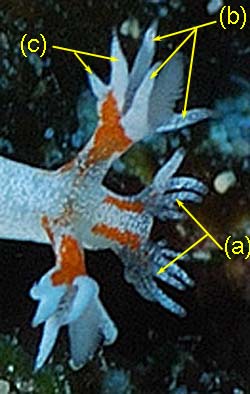This species has been observed on Reunion Island
Species characteristics : The general body colour is translucent white with scattered subepithelial opaque white granules. |

|
|
| Showing species characteristics... | Isabelle Ruffin Reunion, Saint-Leu, "banc de sable", 4m, 10 August 2008, size : less than 20 mm. |
|
| Remarks :
Bibliographic data :
|
 |
References :
Bill Rudman Seaslug site : Sea Slug Forum : Bornella pele
Publications :
Pola, M., Rudman, W. B. & Gosliner, T. M. (2009) Systematics and preliminary phylogeny of Bornellidae (Mollusca: Nudibranchia: Dendronotina) based on morphological characters with description of four new species. Zootaxa , 1975, 1-57.
Other photos of Bornella pele :
 |
Isabelle Ruffin Reunion, Saint-Leu, "banc de sable", 4m, 10 August 2008, size : less than 20 mm. It has lobe-like digitate oral tentacles (a) on each side of the mouth The rhinophore sheath has three elongate anterior and anterolateral papillae (b) spaced around its upper edge, and there is a fourth (c), taller, posterior papilla, which is distinctly bifid. |
Philibert Bidgrain Reunion, Etang salé, on the rocky coast, less 1 m, 12 August 2007, size : 15-18 mm |
 |
 |
Philibert Bidgrain Reunion, Saint Leu, on the surface of the ocean being carried by the current, 7 January 2008, size : 15 mm Behind the rhinophores, there are three pairs of dorso-lateral processes, followed by two single processes in the dorsal midline. There are two parallel red marks (a) on the basal inner side of each dorsolateral process. In that cases the anterior half of red band runs along the dorsal midline, divides into a pair of outer bands (b).
|
Sebastien Pomarede Reunion, Saint Leu, 9 May 2006, size : 15- 18 mm
|  |
More photos from Indian Ocean